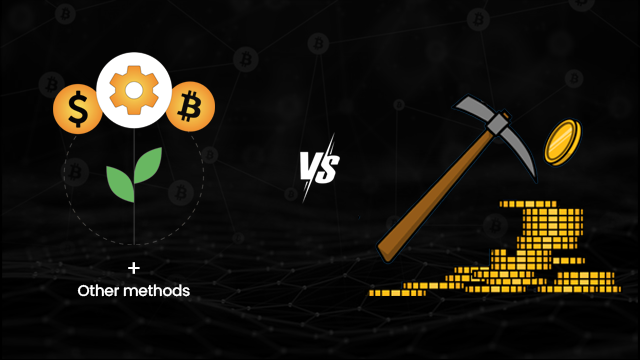TL;DR
Your crypto project’s liquidity strategy is the key to success—whether you’re building a DeFi protocol, launching a token, or scaling on-chain markets. This guide breaks down the pros, cons, costs, and hidden pitfalls of liquidity mining, traditional liquidity providers, and innovative hybrid models, so you can make the smartest choice for your growth.
Understanding Liquidity Mining Fundamentals
Liquidity isn’t a marketing gimmick, but the foundation of token adoption, trading efficiency, and investor confidence. Without it, even the most innovative tokens won’t gain traction. But how you source that liquidity is what separates a sustainable project from one that gets washed out in the first wave of volatility. Let’s understand liquidity and its fundamentals.
Definition and Operational Mechanics
The reward structure typically consists of a percentage of the trading fees generated by the DEX, distributed either as platform-specific DeFi tokens or as liquidity provider (LP) tokens. This creates a mutually beneficial relationship where projects gain necessary liquidity, and providers earn passive income on their otherwise idle assets.
Benefits for Projects Implementing Liquidity Mining
Projects implementing liquidity mining programs can realize several significant advantages:
- Rapid liquidity acquisition: Liquidity mining enables new or existing projects to quickly attract substantial liquidity by offering attractive reward incentives. This accelerates market-making capabilities and reduces slippage for traders.
- Decentralized ownership structure: By distributing tokens to liquidity providers, projects can create broader token ownership, potentially leading to more decentralized governance and community buy-in.
- Global accessibility: Liquidity mining democratizes market-making, allowing anyone with crypto assets to participate without special accreditations or high capital requirements typically associated with traditional market-making.
- Community engagement: Rewarding liquidity providers creates a stakeholder community with aligned incentives for the project’s long-term success, fostering loyalty and advocacy.
Inherent Risks and Challenges
Despite its advantages, liquidity mining presents several challenges that projects must carefully consider:
- Impermanent loss exposure: Liquidity providers face the risk of impermanent loss when the relative prices of tokens in a liquidity pool fluctuate, potentially resulting in less value than if they had simply held the assets.
- Smart contract vulnerabilities: Despite advancements in security practices, smart contracts can contain bugs or code vulnerabilities that could lead to significant fund losses if exploited by malicious actors.
- Potential for wash trading and manipulation: Without proper safeguards, liquidity mining programs can be susceptible to various forms of manipulation, including wash trading to artificially inflate volumes and earn rewards.
- Sustainability concerns: Many projects struggle with long-term sustainability of liquidity mining programs once initial token emissions decrease, leading to “mercenary capital” that quickly migrates to higher-yielding opportunities.
Alternative Liquidity Solutions
While liquidity mining has gained significant traction, several alternative approaches offer different risk-reward profiles and operational characteristics.
Traditional Liquidity Providers
Liquidity provider compensation has historically been structured as fixed monthly payments, often ranging from tens to hundreds of thousands of dollars, depending on market conditions and token characteristics. This approach provides predictable liquidity but comes with substantial costs and verification challenges regarding actual performance.
DEX Aggregators and Liquidity Networks
For projects, partnering with or integrating into such networks can expand liquidity access without maintaining dedicated pools on every platform. This approach leverages existing liquidity infrastructure rather than building it from scratch.
Marketplace-Based Liquidity Solutions
The marketplace approach to liquidity provision, as exemplified by Hummingbot’s liquidity mining model, attempts to address traditional Liquidity Providing limitations through an open marketplace where multiple providers compete to supply liquidity. This model uses frequent order book snapshots to reward providers based on the risk they assume, with tighter spreads earning higher rewards.
Specialized Liquidity Hubs
Comparative Analysis: Selecting the Right Approach
Choosing between liquidity mining and alternative approaches requires careful consideration of several critical factors that impact both short and long-term success.
Decision Framework for Projects
Selecting the optimal liquidity solution requires a structured approach based on project-specific factors and objectives.
Project Size and Stage Considerations
Token Economics Implications
Each liquidity approach uniquely impacts token economics. Liquidity mining creates additional token circulation through rewards, potentially accelerating distribution but causing dilution for existing holders. Projects must carefully model emission schedules to balance immediate liquidity needs against long-term token value preservation.
Regulatory and Compliance Factors
The regulatory landscape surrounding DeFi continues to evolve, with potential implications for liquidity provision strategies. Liquidity mining programs and yield-generating activities may trigger regulatory scrutiny in certain jurisdictions.
Traditional liquidity providers with established firms might offer more regulatory clarity but require proper disclosure and compliance frameworks. Projects should assess their regulatory risk appetite and incorporate compliance considerations into their liquidity strategy selection.
Implementation Best Practices
Regardless of the chosen approach, certain implementation practices can enhance outcomes and mitigate associated risks.
Effective Liquidity Mining Program Design
For projects implementing liquidity mining, careful program design is essential. This includes:
- Thoughtful token emission schedules: Balance generous initial incentives to attract liquidity with sustainable long-term rates to prevent eventual exodus.
- Security audits: Thoroughly audit all smart contracts associated with liquidity mining to prevent exploits and vulnerabilities.
- Careful pool selection: When utilizing existing DEXs, thoroughly research and select appropriate liquidity pools, considering factors such as trading volume, existing depth, and platform reputation.
- Anti-manipulation measures: Implement mechanisms to detect and prevent wash trading, sandwich attacks, and other manipulative practices that could drain rewards without providing genuine liquidity.
Hybrid Strategy Implementation
Many successful projects employ hybrid approaches, combining elements from different liquidity provision methods:
- Tiered liquidity structure: Maintain professional liquidity providers for core trading pairs while using liquidity mining for long-tail assets or emerging markets.
- Progressive decentralization: Start with centralized liquidity provision then gradually transition to more decentralized approaches as the project matures.
- Diversified platform presence: Distribute liquidity across multiple DEXs, centralized exchanges, and aggregators to maximize accessibility and redundancy.
Continuous Monitoring and Optimization
Liquidity strategies should never be static. Successful implementation requires:
- Regular performance evaluation: Continuously monitor key metrics including slippage, trade size impact, and effective spreads across different market conditions.
- Incentive adjustments: Dynamically adjust rewards based on prevailing market conditions and competitive landscape to maintain optimal liquidity levels.
- Community feedback incorporation: Engage with liquidity providers and traders to identify pain points and improvement opportunities.
- Adaptation to market evolution: Stay informed about new liquidity provision mechanisms and tools, incorporating promising innovations as the ecosystem evolves.
Conclusion
Liquidity provision represents one of the most critical challenges for cryptocurrency projects, with significant implications for trading experience, price stability, and overall adoption. The choice between liquidity mining and alternative approaches involves complex tradeoffs across cost, risk, complexity, and impact dimensions.
As the DeFi ecosystem continues to mature, we can expect further innovation in liquidity provision methods. Projects should remain adaptable, continuously evaluating their liquidity strategies against evolving market conditions, competitive dynamics, and their own developmental trajectories.
The optimal approach for any project ultimately depends on its specific circumstances, resources, and objectives. By thoroughly understanding the available options and implementing thoughtful, well-monitored strategies, projects can overcome liquidity challenges and create the conditions for sustainable growth and adoption.
Ready to refine your liquidity strategy?





